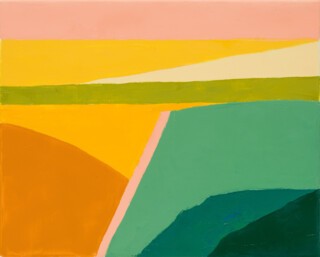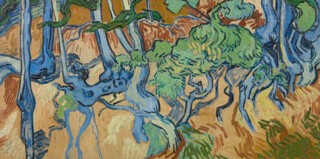Etel Adnan’s small canvases burn brightly. They are hard to shake, lingering on the retina: bright yellows, ochre, burnt orange, mustard, mauve, teal. Her subjects are horizons, suns, mountains, celestial bodies, landscapes that slide into geometric abstraction. Colour, she said, in a nod to Nietzsche, was ‘total affirmation … Colours exist for me, as entities in themselves, as metaphysical beings, like the attributes of God exist as metaphysical entities.’ Colour is a serious matter in her paintings.
This sensibility underpins Colour as Language, an exhibition at the Van Gogh Museum in Amsterdam (until 4 September) that pairs Adnan’s work with paintings by Van Gogh. ‘Colour expresses something in itself,’ Van Gogh wrote in 1885. ‘One can’t do without it; one must make use of it. What looks beautiful, really beautiful – is also right.’ Adnan, who died in November 2021, aged 96, applied her colours in flat swathes, using a palette knife. She worked with the canvas placed flat on the table, and often finished paintings in a single sitting – a practice she attributed to starting out as a writer. ‘I attack the surface as if I am writing. With Van Gogh there is that same approach to writing underneath the painting. To a degree, he writes on his canvas, he is writing a landscape.’
The question of language was complicated by her own itinerancy: she was born in Beirut to a Greek mother and Turkish father, studied in Paris and then in the US, where she lived in Sausalito, before returning to Beirut again, Sausalito again, then Paris again, with another home in Erquy, on the coast of Brittany. As a child, she spoke Greek and Turkish at home, French at school and Arabic in the streets. While in California, she spoke and wrote in English. After the Algerian War, French no longer seemed to her a humane language. She wrote of her adopted country that she would ‘disappear without having resolved the turbulent emotions that come over me when I think of her … All her colonial past and the remnants of that past that get stuck in my throat.’
Can one ‘write’ a landscape or ‘speak’ in colours? Adnan liked to say that she painted in Arabic, but also that painting was ‘a language that’s not meant to be translated into words’. Abstract art, in particular, allowed her to ‘move in different directions … not on single planes but within a spherical mental world’. In this world, problems became ‘tensions’, which worked in ways ‘more mysterious … than we understand’.
The exhibition curators make the case for the natural world as the logical subject of both artists. ‘In all of nature, in trees for instance,’ Van Gogh wrote to his brother, Theo, in December 1882, ‘I see expression and a soul.’ Adnan, too, saw something in her landscapes that transcended the physical world: ‘Painting landscapes is creating cosmic events. The actual space of the painting – its very dimensions – is the space of memory.’ In Van Gogh’s Orchards in Blossom, View of Arles (1889), the trees are just coming into bloom, their trunks and bare branches snaking upwards against a bright blue sky. One tree, more sparsely flowered than the others, is set close to us in the foreground of the picture, darker and richer in colour than its neighbours: a radiant mauve with violet shadows and orange stumps where limbs have been hewn. Tree Roots, painted a year later, has an even more idiosyncratic palette. It was made in Auvers-sur-Oise, where Van Gogh spent his final months, and verges on complete abstraction. Set across the wide rectangular canvas is a tangle of thick, knotted roots, painted in pale blue and indigo with thick black outlines and highlighted here and there with long impasto strokes of yellow. Streaks of green, taupe and brown writhe around the roots, which seem to spring from nowhere and grow everywhere. It’s as if, Adnan wrote of Van Gogh’s work, ‘nature was alive and conscious, and wants to affirm its presence.’
From the 1970s onwards, Adnan made dozens of images – watercolours, drawings, paintings – of Mount Tamalpais, the highest point in Marin County, which she could see from her home in Sausalito. In two works from the mid 1980s, Untitled (Mount Tamalpais) and Mount Tamalpais, the mountain is an elaborate patchwork of colours. In Untitled, the bright shades build on each other in solid, rounded forms, like clumps of earth or colourful clouds come down to rest. In Mount Tamalpais, the soft foreground colours – pink, salmon, sage, lemon – give way to stormy greys and blues higher up the mountain. There is little to distinguish the peak from the sky beyond it. In later works, this approach was radically simplified, with thinner applications of fewer colours and starker geometric forms. In California #9 (2013), the mountain is a broad ribbon of red with green and pale blue foothills below. Untitled (1995-2000) has the mountain as a sea of greens against a cloudy pink sky. Set in the hills is a small square of bright red, a jolt in the field of colour.
In her memoir, Journey to Mount Tamalpais (1986), Adnan describes the world around her with something approximating the range of her canvases, moving between the concrete and the spiritual. She might begin with an account of the ever-changing morning light on the mountain, before a more characteristically philosophical voice takes over:
It is clear. It is empty. My spirit is anguished by colour. Colour is the sign of the existence of life. I feel like believing, being in a state of pure belief, of affirmation. I exist because I see colours. Sometimes, at other moments, it is as if I didn’t exist, when colours seem foreign, unreachable, impregnable fortresses. But there is no possession of colour, only the acceptance of its reality. And if there is no possibility for the possession of colour, there is no possession at all. Of whatever it is.
Adnan wrote about her admiration for van Gogh’s letters as well as his paintings, and in words, too, the artists appear to think in parallel. ‘The laws of the colours are unutterably beautiful, just because they are not accidental,’ Van Gogh wrote to Theo. ‘One can speak poetry just by arranging colours well.’ Van Gogh’s wheat fields and Adnan’s mountain, which she continued to paint long after leaving California, both wager that if the possibilities of colour were to be fully appreciated, one would need nothing more from life than the view from one’s window.
It’s not surprising that forms and motifs repeat in both artists’ work. But repetition is also a devotional practice. A series of leporellos (the name given to books folded in concertina), made by Adnan between 2004 and 2019, combine drawing, writing, painting and poetry. Some reproduce her own texts, written in Arabic and punctuated by ink and watercolour drawings, while others pay tribute to fellow poets, such as the Lebanese feminist writer Joumana Haddad. Adnan first began making leporellos in the 1970s, drawing on texts by Adonis, Mahmoud Darwish and others. It recalled to her, she said, her childhood practice of copying out Arabic under her father’s instruction, before she could read what she was writing.
The exhibition links these works to Van Gogh with a letter written to Theo on 28 May 1888, in which he sketches a leporello he wished to make for Paul Gauguin and Émile Bernard. But there is an additional link to be made in their use of other artists as sources of both comfort and inspiration. Van Gogh would copy the work of those he admired – Rembrandt, Delacroix, Millet – when he felt unable to create his own images. ‘I find it teaches me things,’ he wrote, ‘and above all it sometimes gives me consolation.’ The Sower (1888) is based on Millet’s painting of 1850, which shows a labourer striding through a bare winter field at dusk, golden seeds flying from his hand. But in Van Gogh’s version it is the sun, not the sower, that takes centre stage, burning huge and yellow behind the dark foregrounded figure.
Though Adnan’s paintings are absent of figures, angels recur in many of her writings. They are invoked as symbols of love, terror, escape, catastrophe, revelation and futurity, appearing frequently in her book-length poem of 1989, The Arab Apocalypse, alongside satellites, lunar voyages and astronauts. In Master of the Eclipse (2009), they are summoned via Paul Klee and his Angelus Novus, which Adnan describes as ‘the prototype of the poets … who will deal with these destitute times. That’s what poets are for: to be the energy, to take part in the perennial physical and spiritual battles waged for the destiny of man.’ These angels refer to an idealised state of grace rather than any particular belief system – or if they do, the belief system is one of Adnan’s own making, one which has making at its centre and in which heaven would be like looking ‘at circles and see[ing] dots in them and in the dots we … discover universes’.
Circles inside circles inside circles. Van Gogh wondered whether life, like the Earth, might be round, a kind of infinity, ‘and very superior in expanse and capacity to the hemisphere we know at present’. The circle dominates a series of Adnan’s late works titled The Weight of the World (2016-18). Sometimes the circle is solitary and large, floating in a coloured expanse above a thin horizon line; at other times it is set alongside another circle or a small rectangle, as if to say, no, we are not alone in the universe.
Send Letters To:
The Editor
London Review of Books,
28 Little Russell Street
London, WC1A 2HN
letters@lrb.co.uk
Please include name, address, and a telephone number.



